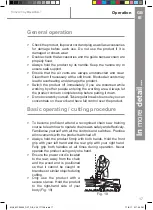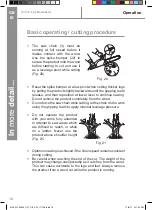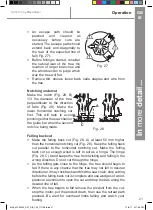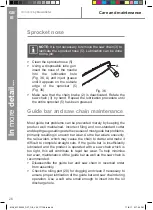
21
MCS2400
by MacAllister
In
more
detail...
GB
IE
Operation
An escape path should be
>
planned
and
cleared
as
necessary before cuts are
started. The escape path should
extend back and diagonally to
the rear of the expected line of
fall (Fig. 27).
Before felling is started, consider
>
the natural lean of the tree, the
location of larger branches and
the wind direction to judge which
way the tree will fall.
Fig. 27
Remove dirt, stones, loose bark, nails, staples and wire from
>
the tree.
Notching undercut
Make the notch (Fig. 28, B)
1/3 the diameter of the tree,
perpendicular to the direction
of falls (Fig. 28). Make the
lower horizontal notching cut
first. This will help to avoid
pinching either the saw chain or
the guide bar when the second
notch is being made.
50 mm
50 mm
A
B
C
Fig. 28
Felling back cut
Make the felling back cut (Fig. 28, A) at least 50 mm higher
>
than the horizontal notching cut (Fig. 28). Keep the felling back
cut parallel to the horizontal notching cut. Make the felling
back cut so enough wood is left to act as a hinge. The hinge
(Fig. 28, C) wood keeps the tree from twisting and falling in the
wrong direction. Do not cut through the hinge.
As the felling gets close to the hinge, the tree should begin to
>
fall. If there is any chance that the tree may not fall in desired
direction or it may rock back and bind the saw chain, stop cutting
before the felling back cut is complete and use wedges of wood,
plastic or aluminium to open the cut and drop the tree along the
desired line of fall.
When the tree begins to fall remove the product from the cut,
>
stop the motor, put the product down, then use the retreat path
planned. Be alert for overhead limbs falling and watch your
footing.
MNL_MCS2400_DFT_GB_V05_111108.indd 21
11/8/11 5:17:36 PM
















































